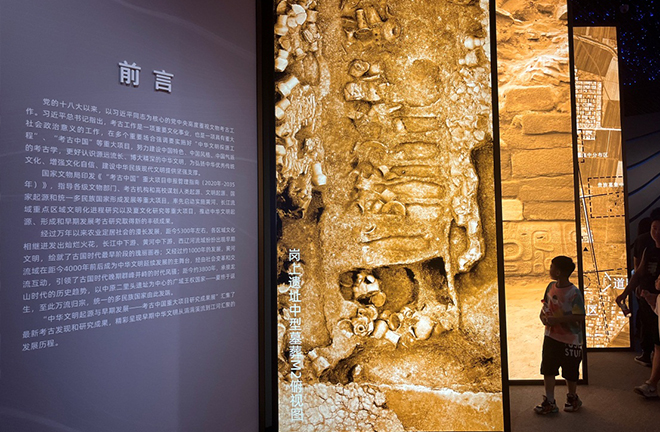Scientific innovation enables protection of cultural relics

An exhibition on research achievements from the Archaeological China project at Shandong Museum in Ji’nan, Shandong Province Photo: Zhang Qingli/CSST
From the Qinghai-Tibet Plateau to the depths of the sea, from laboratories to museums, scientific and technological innovation has been continually providing new and powerful tools for academic endeavors in the fields of cultural heritage and archaeology.
Archaeological explorations
The archaeology of the Qinghai-Tibet Plateau has emerged as a prominent area of study, as researchers delve into the chronology of human habitation and the establishment of permanent settlements on the plateau. Exploring adaptive strategies to the high-altitude environment, as well as interactions among cultures and populations both within and beyond the plateau, continues to be a frontier topic of study in the global academic community.
Recently, a team from Sichuan University (SCU), adopting an archaeological perspective based on interdisciplinary studies, has undertaken an analysis of the migration and cultural transformations of ancient populations on the plateau spanning over 5,000 years.
Lyu Hongliang, dean of the College of History and Culture at SCU, mentioned their endeavors in a large-scale and systematic genomic study of ancient populations on the plateau. The study revealed their pluralistically integrated yet relatively continuous genetic structure over five millennia. The details of the study described the dynamic evolution of plateau inhabitants at different times and places, and highlighted the selective characteristics of genes contributing to their unique adaptability. Such findings have provided scientific foundations for a deeper comprehension of the interplay between humans and the environment.
A recent series of major discoveries, including ancient shipwrecks in the South China Sea, has garnered widespread attention, showcasing the vast prospects of interdisciplinary integration between deep-sea technology and underwater archaeology. In June 2023, China began the construction of its first-ever vessel dedicated to deep-sea and far-sea multi-functional scientific investigation and cultural relic archaeology. This groundbreaking development is taking place at the Guangzhou Shipyard International Company. The construction of this ship marks a significant milestone for China, as it will greatly enhance the country’s capabilities in conducting deep-sea archaeological operations.
The ocean has played a crucial role as venues for the dissemination and development of human civilizations, with submerged cultural relics scattered on the seabed, harboring a wealth of historical and cultural value. Under the support of the National Key Research and Development Program of China, a project for underwater archaeological detection has been initiated to develop key technologies and platforms for Autonomous Underwater Vehicles (AUV), which specialize in deep-sea archaeology and are capable of operating at depths up to 1,000 meters.
According to Xu Gaofei, an engineer at the Institute of Deep-Sea Science and Engineering at the Chinese Academy of Sciences, a specialized AUV system tailored for deep-sea archaeology has been developed following three years of efforts. This system demonstrates the ability to conduct both broad-scale, rapid searches and close-range, high-resolution detection underwater. However, the field of deep-sea archaeology is still in its nascent stages, primarily due to limitations in sensor technology. There are still extensive unexplored areas in the deep sea, harboring numerous potential underwater cultural relics that await discovery and further exploration.
Preservation of cultural relics
With the implementation of a cultural heritage conservation and utilization project under the National Key Research and Development Program, research teams from museums, universities, and institutes across the country have made a wide range of accomplishments and technological breakthroughs. These encompass conservation technologies for immovable cultural relics such as cave temples, ancient buildings, archaeological sites, and murals, as well as for movable artifacts such as paper, silk cloth, metal, and brick and stone. Additionally, significant progress has been made in the integrated quakeproof protection of museum collections, and the construction of risk monitoring and regulation systems for cultural heritage.
The China Academy of Cultural Heritage (CACH) has researched key technologies for predicting and reinforcing rock mass stability in cave temples. The program has focused on the instability mechanisms of rock masses in cave temples, stability assessment and monitoring, as well as reinforcement materials and techniques. Meanwhile, it has launched demonstrative applications at the North Grotto Temple in Qingyang, Gansu Province, and the Yuanjue Cave in Anyue, Sichuan Province.
CACH Vice President Li Li said that they have been actively working on the integration, R&D, and application of detection technologies of the multi-scale structure of grotto rock mass, revealing its time-dependent deformation by means of laboratory tests and numerical simulation. They have carried out multi-scale and multi-dimensional data monitoring at the North Grotto Temple and the Yuanjue Cave. This endeavor has resulted in many positive contributions to a comprehensive scheme for monitoring the stability of cave temple rock mass.
The digitalization of cultural relics serves as a crucial foundation for bringing cultural heritage to life, thereby ensuring the long-term preservation and better utilization of historical cultural resources, said Xie Mei, director of the Digital Culture and Media Research Center at the University of Electronic Science and Technology of China. Specifically, it aims to establish databases for cultural relic resources, conduct the digital management of technological venues, create immersive cultural products, and promote the symbiosis of reality and virtuality through constructing “metaverse” cultural scenes.
Edited by YANG LANLAN
